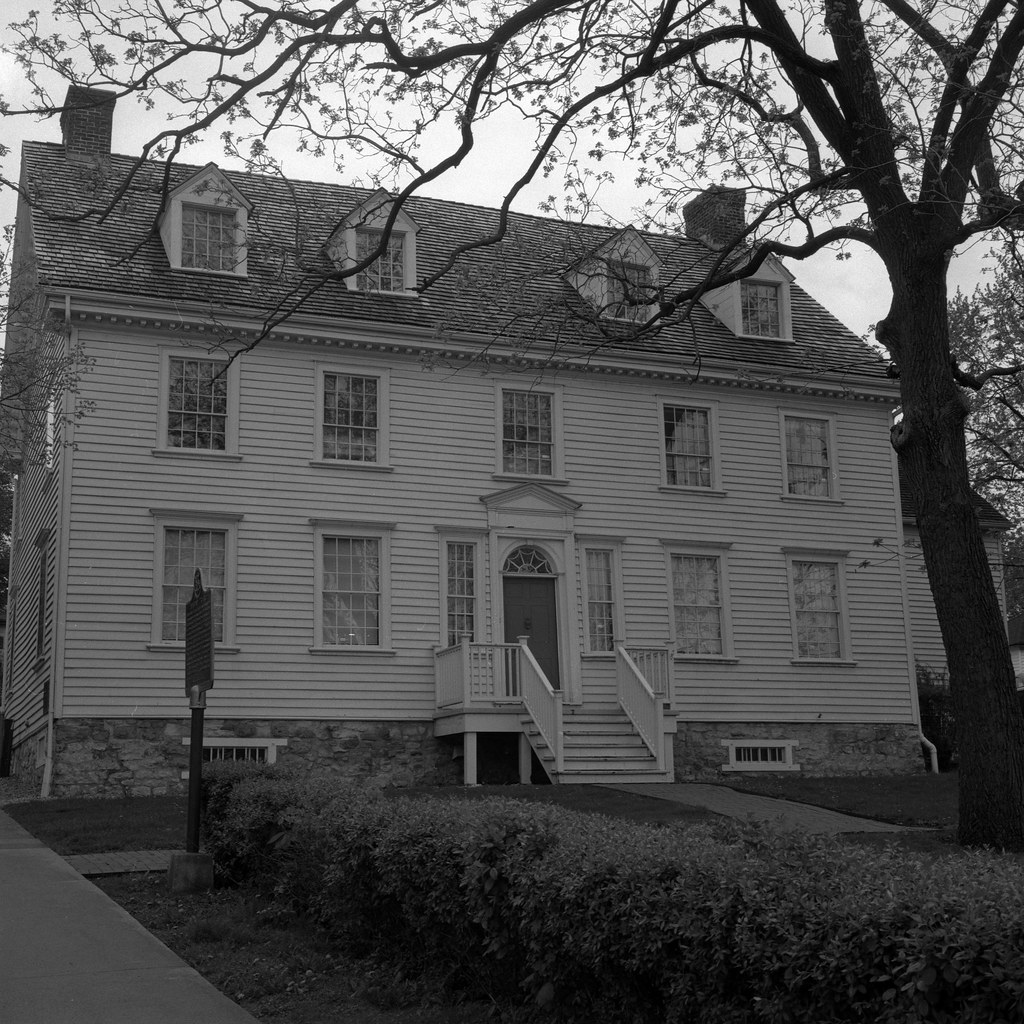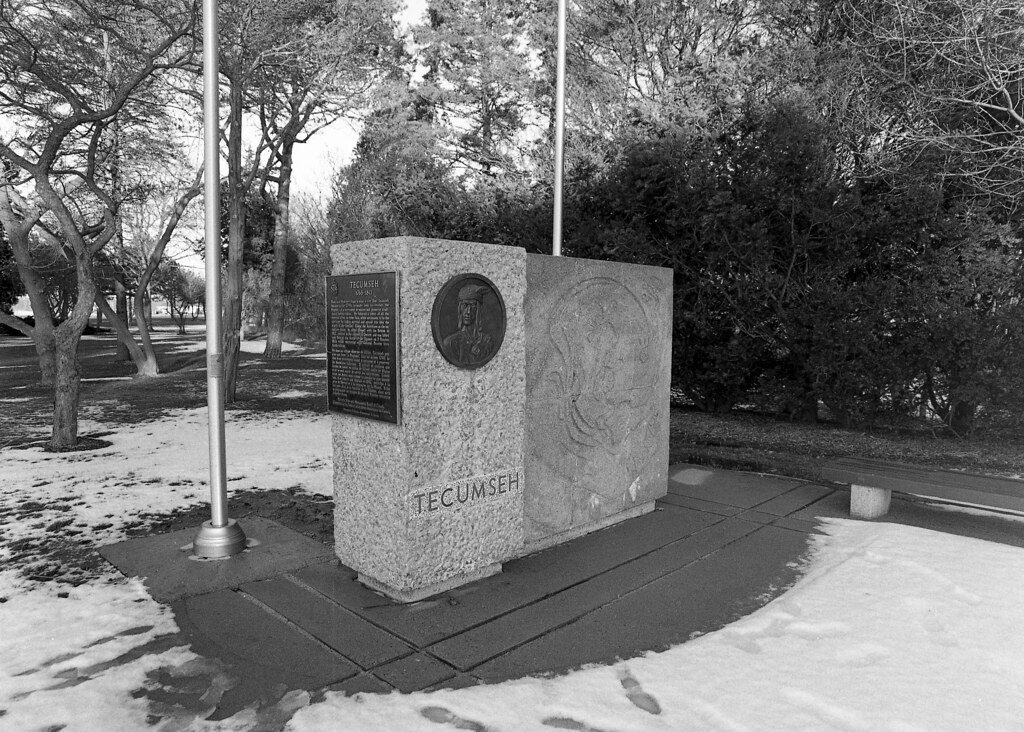Many things can be used to describe the Shawnee leader Tecumseh. Hero, Legend, Warrior, Hunter. Like many who fought in the war, Tecumseh’s name only became larger after his death, following in the line of those like Perry, Harrison, Brock, and Secord. But the war was in Tecumseh’s blood, despite him wanting nothing more than peace. Born in the latter half of the 1760s in the Ohio Valley, he was born into conflict. His true name, Tecumethe, meaning shooting star, was given to him as he was born under such an astrological sign. However, history has named him Tecumseh. The Shawnee had been forced to live as nomads, scattered across the United States after the American Revolution, for they had sided with the British. That alliance had done little for them, landing them in the ever-expanding American people.

Bronica SQ-Ai – Bronica Zenzanon-S 80mm 1:2.8 – Kodak Tri-X 400 @ ASA-400 – Kodak Xtol (Stock) 7:00 @ 20C
Hasselblad 500c – Carl Zeiss Planar 80mm 1:2.8 – Ilford FP4+ @ ASA-100 – Formulary Developer 23 (Stock) 6:00 @ 20C
Tecumseh’s life could be defined as being constantly on the receiving end of American manifest destiny. Treaty after treaty, conflict after conflict, much of the Indigenous population of what would become the old American North-West found themselves being pushed further and further off their traditional territories. Life under the British had been no better, but minor skirmishes were turning into full-scale war. After the American Revolution, to further extend their influence, the fledgling United States of America began a fight to take control of the Northwest, the North-West Indian War, fought from 1786 to 1795, ending with the Battle of Fallen Timbers near modern-day Maumee, Ohio and the Treaty of Greenville forced many of the peoples who fought in the battle to give up large amounts of land to the hungry Americans. Techumseh, taking note of the Mohawk War Leader Thayendanegea (Joseph Brant), called for the unification of all Indigenous peoples. Tecumseh and his brother, Tenskawatawa (The Prophet), led a large group of people and established Prophetstown in 1808. Located near the confluence of the Wabash and Tippecanoe Rivers, the settlement grew. While many other indigenous peoples flocked to the call to form a great confederacy, it put them in direct conflict with the newly minted governor of the Northwest Territory, William Henry Harrison. While they did not directly attack American settlers, they did conduct raids against them. Harrison had been tasked with gaining land titles from the native occupants, and the two Shawnee leaders’ teachings were not helping in this. But neither side wanted conflict. But with the signing of the Treaty of Fort Wayne, Tecumseh finally met with Harrison in 1810. His request, nullify the treaty, or there would be war. Harrison refused to back down, so Tecumseh went to Fort Amherstburg to meet with the British. England was already on rocky ground with the Americans following the Chesapeake-Leopard Affair but provided weapons and ammunition. It was Tecumseh’s constant trips to gather more tribes to his cause that both saved and damned him. While he was away, Harrison, at the front of 1,000 troops, went to Prophetstown to find a peaceful resolution to the situation. However, the battle that ensued saw the settlement of Prophetstown destroyed. Tecumseh had no choice but to head north.

Hasselblad 500c – Carl Zeiss Planar 80mm 1:2.8 – Ilford FP4+ @ ASA-100 – Formulary Developer 23 (Stock) 6:00 @ 20C
Rolleiflex 2.8F – Carl Zeiss Planar 80mm 1:2.8 – Ilford Delta 400 – Kodak TMax Developer (1+4) 6:30 @ 20C
At Fort Amherstburg, Tecumseh met a man who he both saw as his equal but the man who saw him as an equal, General Isaac Brock. Together the two leaders organized and executed the capture of Fort Detroit. This action not only rallied the British and Canadian forces but had native warriors flocking to the banner of Tecumseh and Brock’s promise to turn over what was the Michigan Territory to the natives as a land of their own. But this also gave Brock a much-needed weapon against the Americans, fear. Warriors fought alongside British and Canadian troops in every theatre of the war and even launched their attacks throughout the United States in the name of Tecumseh. But with the death of Brock in October of 1812, Tecumseh soon found himself at odds with the officers that followed. The notable one was Henry Procter, who was given command of the British forces in the west. There was a conflict between the two right off the bat, with the disaster at the River Raisin, to Procter’s poor handling of native allies at the first siege of Fort Meigs, where Tecumseh told Procter to put on petticoats, in effect saying that Procter was unworthy of command. The conflict between the two effectively destabilized the British control over the west, giving Harrison precisely what he needed. Failures at Fort Meigs (twice) and Fort Stephenson and the eventual loss of Lake Erie would box the two men in. While Tecumseh wanted to stay and fight, he eventually had no choice but to follow Procter to Burlington Heights but continued to push the British to turn and face the enemy rather than run, tail between their legs. It would be at Moraviantown that Tecumseh is given his chance. Procter and the British would run after a single volley leaving the warriors to their brief but bloody fight. Tecumseh would meet his end on the banks of the River Thames, shot by an officer under General Harrison.

Rolleiflex 2.8F – Carl Zeiss Planar 80mm 1:2.8 – Rollei RPX 400 @ ASA-400 – Kodak D-76 (Stock) 8:00 @ 20C
Pentax 645 – SMC Pentax A 645 35mm 1:3.5 – Kodak Tri-X 400 @ ASA-200 – Kodak HC-110 Dil. E 6:30 @ 20C
While the confederacy was already failing in the face of overwhelming odds and conflict, the death of Tecumseh ended the dream. However, the legend of Tecumseh only grew in his death. Having never been recovered from the battlefield, his body was probably buried among the other dead in the aftermath. However, many have claimed to have the remains of the great Shawnee Chief. Tecumseh is viewed as a hero both in Canada and the United States, and monuments and memorials have been built, and many men (often white men) carry his name. Here in Ontario, there is a township in Western Ontario that bears his name. A driving route from Fort Amherstburg (Malden) follows roughly the path through Chatham to the field of battle known as the Tecumseh Parkway, marked with several stops and plaques along the way. In 2013 a group of reenactors replicated the battle on the original site, marked with plaques in English, French, and Algonquian.
Written with Files from:
Guidebook to the Historic Sites of the War of 1812 Second Edition by Gilbert Collins – 2006 The Dundurn Group Publishers
Tecumseh and Brock: The War of 1812 by James Lexer – 2012 House of Anasi Press Inc.
Web: www.eighteentwelve.ca/?q=eng/Topic/6
Web: www.warof1812.ca/tecumseh.htm